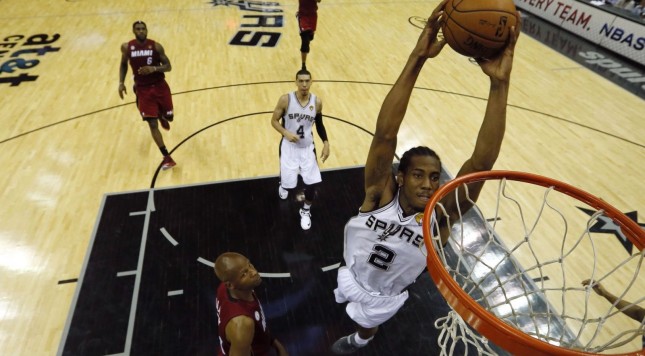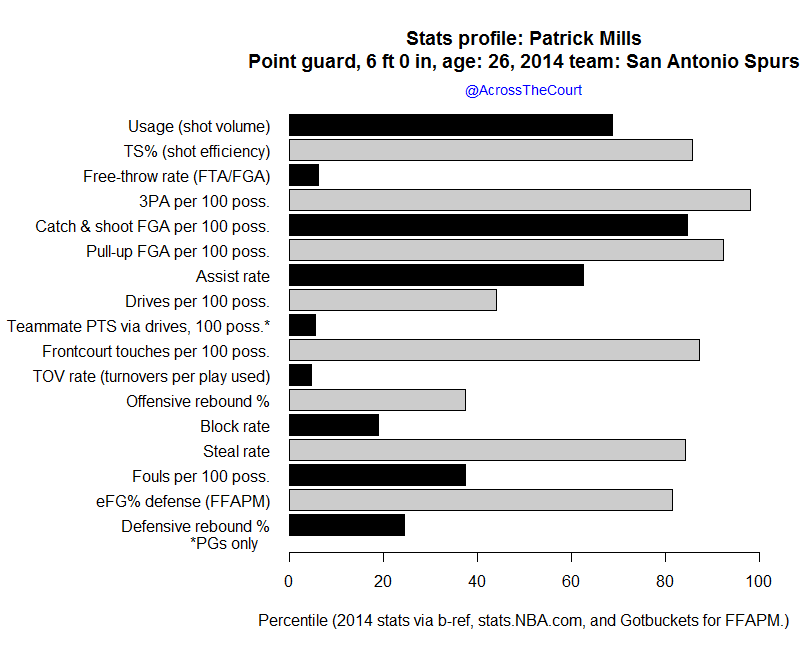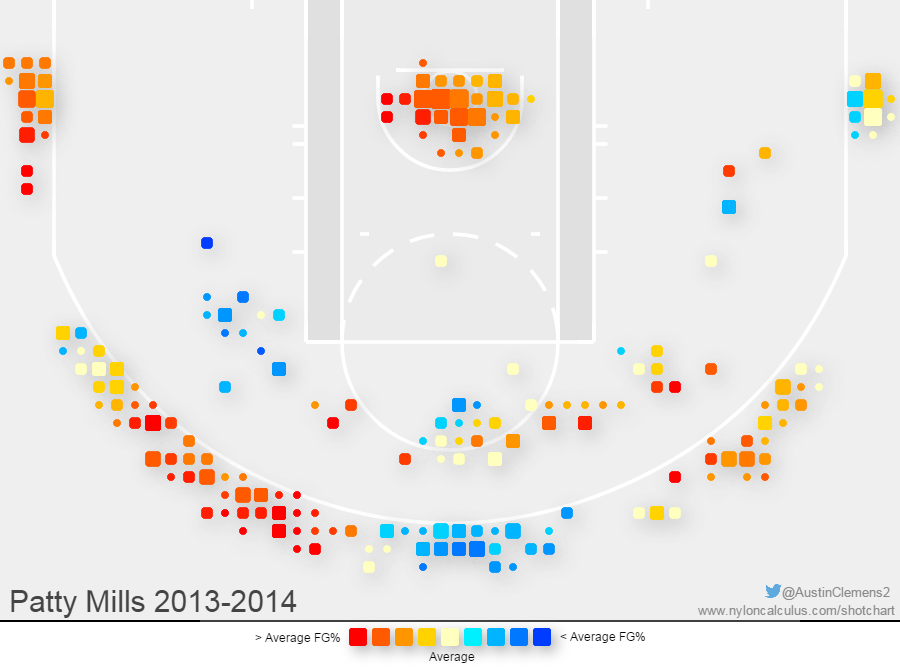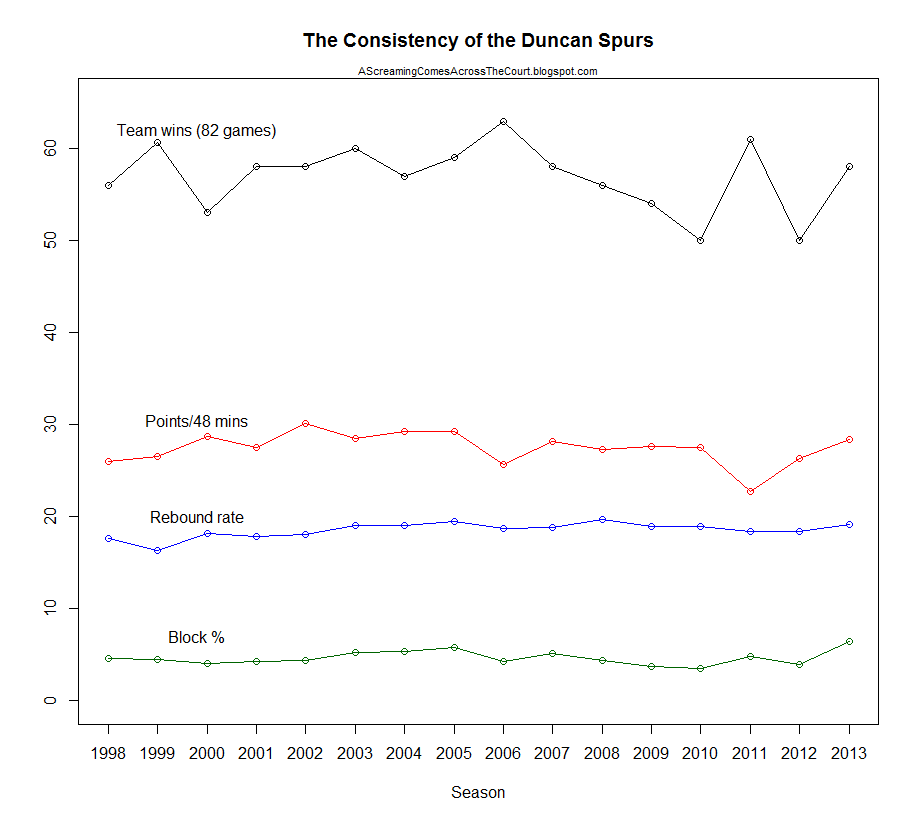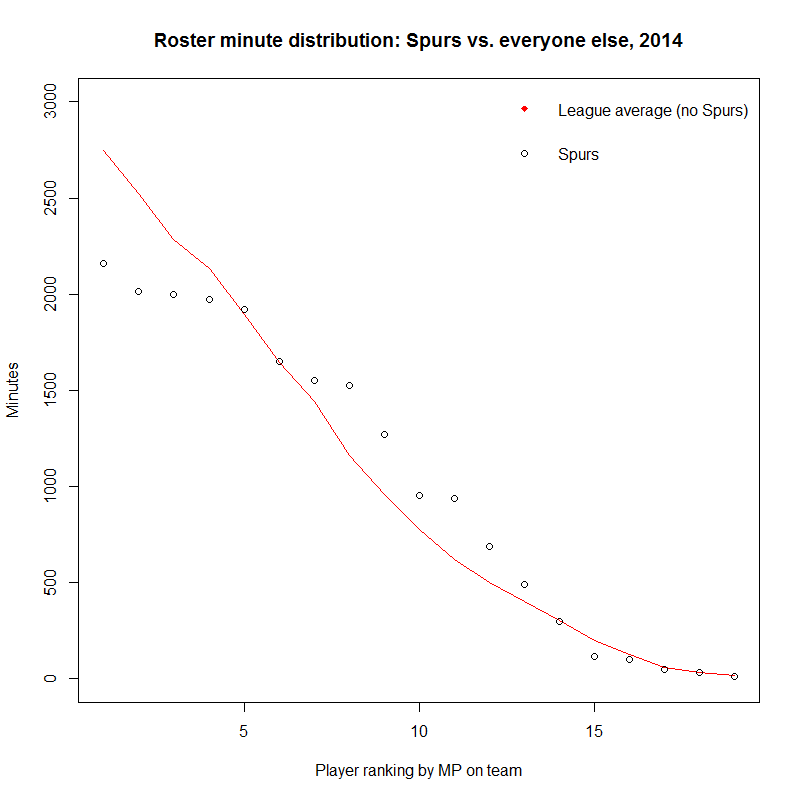Historically, the Spurs title last season is an important beacon in the time of the super-team and all-stars joining forces. It was a true ensemble squad with no one averaging more than 17 points per game or 30 minutes where the only all-star and all-NBA player was Tony Parker, who probably wouldn’t have earned those distinctions if his team weren’t so good. Ten years ago, another ensemble squad knocked off a super-team of legends and broke them up forever: the Detroit Pistons. There is no one “true” way to win, but we needed to be reminded you can win without a superstar in his prime. There are five guys on the court and they all count.
2014 in review
I’m not sure if people understand how dominant the Spurs were. This should be in the conversation for one of the best teams ever and it’s the best Duncan team given how people write off the lockout season anyhow. They won 62 games with an adjusted point differential of 8 despite never playing anyone over 30 minutes per game, which is completely absurd. Teams kill their best players to ride them to 50 plus wins and Popovich trolls everyone with an epic rest program that lets them snag homecourt advantage. The Spurs confirmed their status as the gold standard for how to manage a franchise with the title, and as people have learned we can never count out Duncan, Parker, and Ginobili and we should never bet against the Spurs.
Changes
Exit: Nando De Colo, Shannon Brown, Damion James, Othyus Jeffers, Malcolm Thomas.
Enter: Kyle Anderson.
The guys who left the team only totaled 503 minutes for the Spurs last year. De Colo was the most relevant player and he was only in 26 games. The big piece they’re adding is rookie Kyle Anderson, a unique player who blew up advanced draft models but fell because of conventional analysis and concerns about how to fit his game onto a team. It’s hard to describe him with any player in the league. He plays like a hybrid of Larry Bird and Shaun Livingston as a ground-bound lanky point forward with a good shooting stroke. But the closest comparison to a modern player is, of course, Boris Diaw. Anderson is the perfect fit the Spurs and may be another in the long line of draft day steals.
Player spotlight
The Spurs have been outperforming expectations for years, and they do this by targeting undervalued guys who would fit in well with their team. Patty Mills was one of the latest finds and after a couple of seasons on their bench he had a breakout season as a key reserve for what was probably the greatest bench ever. Referring to his stats below, he’s a shoot-first point guard who subsists on a high number of jump shots including ones off the dribble. For a point guard, he doesn’t net a high number of assists or drives, however, and when he does drive it’s usually to score. Only D.J. Augustin and Vasquez created fewer points for teammates on drives among point guards, and they played for worse offenses. Luckily, he was an efficient scorer with a tiny turnover rate and a shot volume that isn’t too oppressive for other players. The turnover rate might be an outlier based on his previous seasons, but he should remain a good shooter.
Patrick’s defense is a bit unclear and his good metric scores could be buoyed by the other defenders on his team. He does pick up a fair number of steals, however, and for his size his defensive rebounding is pretty solid. Checking with the new defense player tracking tab for 2014, Mills allows more points than expected on shots defended except for three-pointers. He was killed on long two-pointers, which could be a one-year blip, but overall breaking things down into zones players shot about 2 percent better on average when he defended them based on their “usual” shooting percentages.
Based on Patty’s shot chart from this season and his past trends, he’s a very good three-point shooter who’s adept at pulling-up and nailing shots. In fact, according to SportVU, he shot 8 percentage points better on those three-pointers at an extremely high 48%. He also liked the zone in the shape of a crescent moon at the top of the key. He was great at finishing at the rim last season, and even if he regresses to his career averages he’ll still be above average — impressive for a short point guard. However, he doesn’t draw many fouls.
Patrick Mills’ offense can be seen in the playlist below. In the first video he curls around a pick and hits a midrange shot in his sweet zone. The second video is a patented sneaky Spurs give and go with Ginobili in semi-transition. They use that a lot with Tony Parker too. In the third clip, a bigger defender gets switched onto Patty and gets caught in a screen; he uses that to his advantage and hits a three when he sees that daylight. In the Spurs system, you can expect to see a lot of open three’s, and he reaps the benefits in the fourth video. The last video has Mills initiating his own drive, which he actually doesn’t do as often as you’d think for scoring guard. He blows by Livingston, who was a little distracted, and scored over the defense inside.
Mills is usually hidden on weaker defenders where he does a fine job, but he can be exploited by elite scorers — though even the best defenders can. In the first video below, he’s guarding Curry, sticks close to him, and allows him to go all the way to the rim for a layup. It’s not terrible defense and you rely on your big men for weakside help, but it shows how he’s definitely not a stopper but is fairly decent. Based on the defensive player tracking stats, Mills will chase a guy off the line and steer them toward an interior defender. You can see another example of this in the second video with Lillard, a dangerous shooter. He’s well versed at this, however, and uses his quickness to stay with guys to keep them from shooting.
Unfortunately, Patrick Mills will be out a few more months with a shoulder injury. The Spurs will try to fill in the gaps with Manu/Marco as the backup ballhandlers and probably more minutes from Tony Parker along with third string point guard Cory Joseph. They’ll miss his scoring punch and his ability to hit shots on the move. The Spurs could be vulnerable whenever Manu is out as their unmatched depth will be merely mortal with a lack of guard playmaking. But he’ll be back for he second half of the season and the only part of the year that matters to San Antonio: the playoffs.
2015 projected
Time’s glory is to calm contending kings,
To unmask falsehood, and bring truth to light.
-Shakespeare
Time has destroyed previous NBA empires, rendering them to rubble and scars indicating what used to be. When Duncan won his first time, the Kobe-Shaq Lakers were just coming into their own and then dominated the league for the next three years. Then they lost to the Spurs in 2003 and broke up a year later after being devoured by the legendary Detroit defense. The Spurs stayed together and added new pieces, then won again in 2005, fighting off the Pistons. That same year marked the ascendance of the Nash Seven-seconds-or-less era in Phoenix. The Spurs, however, outlasted them all: the Pistons faded away while the Spurs beat Phoenix in 2007 and saw them break apart when Nash left.
But new challengers sprung up in 2007 after some big trades. The Garnett-Pierce-Allen Celtics won a title in 2008, while the Kobe-Pau-Odom Lakers won the next two during a Spurs lull. Those two empires were fairly short-lived given the age of their pieces, but in 2011 LeBron, Wade, and Bosh joined forces, which seemed like an unbeatable force for years to come. After winning a title in 2012, they beat the Spurs in the finals the next year — one underrated gem is that LeBron and company are the first to beat the Spurs in the finals and that Duncan himself gave LeBron his first finals loss in 2007. But after the Spurs enacted revenge by humiliating them a few months ago in the finals, Miami, like all previous empires, broke up — the Spurs have outlasted everyone. Their dynasty will eventually succumb to the sands of time, but it’s hard to believe that’s possible. Before last season, I noted Duncan and his team’s maddening consistency. Looking at that graph below, and it’s hard believe that’s even possible.
Other than the injury to Mills and the rookie Anderson, there’s nothing new to say about the Spurs. They are who they are, forever experimenting and staying one step ahead of everyone else. What they accomplished was a title for old man Duncan and a validation of their successful program in reinventing the team. But now what? Snag that elusive back-to-back title?
The fear everyone has had about the Spurs going forward is what they’ll do without Duncan, and by the time he’s gone Manu will mostly likely be as well and Tony Parker won’t be the same. As awesome as their role players are, as great as their execution is, they still need the top-level personnel to compete with the best.
One secret criticism of San Antonio is that it’s been 13 years since they last drafted an all-star with Tony Parker. Kawhi Leonard has a finals MVP trophy, but so does Cedric Maxwell and he’s never been to an all-star game. It’s quite possible Leonard is never an all-star or all-NBA player, and if he does go it’ll be like Luol Deng or Iguodala joining one: a defensive pest with an all-around game representing his good team. Leonard was on a deep team, but a 18.3 usage rate does not signify a typical star and based on my own research even on a worse offense he’d still only be around a 20 league average usage rate. Obviously, his contributions aren’t tallied by the typical measurements like points per game, but he may never be a franchise cornerstone.
Looking back at recent Spurs draft history, you can see them trying to recreate the Parker-Manu draft magic. They had a coveted asset in the 2007 draft with a South American who was pegged by many as one of the best in the world outside of the NBA. People were awaiting another twin-towers setup, and when he finally came over … he was just a solid starter. Splitter’s a great defender and finishes well at the rim, but he’s far from a star and he’s already 29 years-old. San Antonio thought they struck gold again with Luis Scola, one of the best players outside the NBA for years, but they didn’t like how he’d fit in with the team and they ultimately traded him to Houston. But he was a prized draft pick way back in 2002, his rights held for years until he finally played in 2008. Ian Mahinmi was a typical project center, and the Spurs developed him for years before giving him up in a trade for Leonard. They did draft an all-NBA player, however, a few years ago, but they immediately traded his draft rights: Goran Dragic.
The Spurs can’t rely on their stars forever, and they’ll inevitably have to retool with more talent. Unfortunately, Popovich is too old to endure a full rebuild and it’s difficult seeing how they can bring in elite young talent without disruption. They’ve been able to stave off this looming disaster at the horizon with a crazy rest program, however.
This fact has been repeated ad nauseum, but the Spurs had a seemingly impossible combination of resting their best players and winning the most games. Comparing them to the league average in the graph below, the Spurs are an oddity playing their best guys like they’re the 4th and 5th guys in the pecking order, and they rely more on their reserves more than anyone. They gave 1542 fewer minutes to their top four guys than everyone else, and 1591 more minutes to their 5th through 13th guys in the rotation. In fact, that graph is underrating them: rebuilding teams cycle through different players. Playoff teams usually play their top guys heavy minutes. The Mavericks, for instance, played their top 4 guys 600 more minutes on average.
The team will, again, be one of the top defenses, especially if Splitter has a healthier season. The Leonard-Splitter-Duncan foundation ensures high-level defense, and they use few defensive liabilities. The offense will depend on the health of Parker, Ginobili, and the timetable of Patty Mills. Duncan’s post-game and bank shot can’t drive a modern NBA offense — the Spurs reinvented the team by driving the offense through their guards and used more outside shooting.
The indeterminate variable here is Kyle Anderson. He’s nicknamed slow-mo for his snail-slow drives moving as fast as old man Andre Miller where, aided by his 6′ 9″ frame with super long arms, he’s a dangerous scorer and can also whip around passes to almost any spot on the court. He has the standing reach of a power forward and can rebound like one too, but he plays like a point guard. However, the Spurs are well-reversed in running the offense on the bench off of non-point’s — see the breakdown of Patty Mills and how he’s a scorer. Manu is effectively the backup point guard. It’s unclear which position Kyle can defend: he’ll need more strength for power forward, and his outside shot needs to be more consistent for a wing position. Yet draft ratings pegged him as one of the best guys in the entire draft with some star potential — the Spurs have had too few steals of that caliber in recent years and will need one again to continue their master project.
Summary
The Spurs steamrolled the league last year and they’ve had no major losses, the only decreases being due to Father Time. They are, of course, a contender yet again. Just watch out for a slow start from their bench for the season while Mills is out and Popovich acclimates to Kyle Anderson. Basketball-reference’s new stat BPM, a statistical plus/minus model using box score stats, rated Leonard as the best player last season, and this year he could really separate himself and has a shot at the all-star team. With Love in the east and few elite forwards relatively speaking in the hyper-competitive conference, coaches could anoint him as the representative with Duncan and Parker a year older. (Griffin, Durant if healthy, Aldridge, and Davis are the sure bets, and after that it’s a weak crop.) Then again, Popovich could play everyone 25 minutes and force every player to rest with an “injury” during the all-star break and no one would be surprised. Just be wary in predicting their demise. People have failed at this exercise for a decade running.
Wins: 57
Losses: 25
Conference rank: 1st (tied)
League offense rank: 8
League defense rank: 3




















